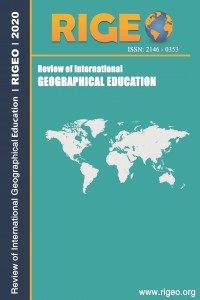A Geospatial Online Instruction Model
Anahtar Kelimeler:
-
A Geospatial Online Instruction Model
Keywords:
-,
___
- Aud, S., Hussar, W., Kena, G. Bianco, K., Frohlich, L., Kemp, J., Tahan, K., Mallory, K., Nachazel, T., & Hanne, G. (2011). The Condition of Education 2011. National Center for Education Statistics, U.S. Department of Education.
- Banta, T. W. (2007). Can Assessment for Accountability Complement Assessment for Improvement? Peer Review, 7: 9 - 12.
- DiBiase, D. (2000). Is Distance Teaching More Work Or Less? American Journal of Distance Education, 14(3), 6-20.
- DiBiase, D., & Rademacher, H. (2005). Scaling Up: Faculty Workload, Class Size, and Student Satisfaction in a Distance Learning Course on Geographic Information Science. Journal of Geography in Higher Education, 29 (1), 139-158.
- Gewin, V. (2004). Mapping Opportunities, Nature, 427, 376-377.
- Gober, P. (1998). Distance Learning and Geography’s Soul, AAG Newsletter, 33(5), 1–2, (Washington, DC: Association of American Geographers).
- Jiangyi, D., & Yan, N. (2009). The Design of a Distance Learning and Teaching System based on Internet. IITA International Conference on Control, Automation and Systems Engineering, 430-433.
- Liimakka, R., Eugene, L., & Leick, A. (2010). Geospatial Education: Distance Learning Opportunity at Michigan Tech. Journal of Surveying Engineering, 136 (4), 148-149.
- Martin, M. (2005). Seeing is Believing: The Role of Videoconferencing in Distance Learning. British Journal of Educational Technology, 36(3), 397-405.
- Palloff, R. M., & Pratt, K. (2001). Lessons from the Cyberspace Classroom: The Realities of Online Teaching. San Francisco: Jossey-Bass.
- Phipps, R. A., Wellman, J. V., & Merisotis, J. P. (1998). Assuring Quality in Distance Learning, A Preliminary Review. A report to Council for Higher Education Accreditation by the Institute for Higher Education Policy. Council for Higher Education Accreditation, Washington, DC.
- Rockwell, S.K., Schauer, J., Fritz, S.M., & Marx, D. B. (2002). Incentives and Obstacles Influencing Higher Education Faculty and Administrators to Teach via Distance, Online Journal of Distance Learning Administration, 2(4).
- Schifter, C. C. (2000). Faculty Motivators and Inhibitors for Participation in Distance Education, Education Technology, 40(2), 43–46.
- Schweik, C. M., Fernadez, M. T., Hamel, M. P, Kashwan, P., Lewis, Q., & Stepanov, A. (2008). Reflections of an Online Geographic Information Systems Course Based on Open Source Software. Social Science Computer Review, 27: 118.
- Shelton, K. (2011). A Review of Paradigms for Evaluating the Quality of Online Education Programs. Online Journal of Distance Learning Administration, IV (1).
- Skopek, T. A., & Schuhmann, R. A. (2008). Traditional and Non- traditional Student in the Same Classroom? Additional Challenges of the Distance Education Environment. Online Journal of Distance Learning Administration, XI (1).
- Solem, M. N. (2001). Choosing the Network Less Traveled: Perceptions of Internet-Based Teaching in College Geography, Professional Geographer, 52(2), pp. 195–206.
- Valentine, D. (2002). Distance Learning: Promises, Problems, and Possibilities. Online Journal of Distance Learning Administration, V (3).
- Wright, D., & DiBiase, D. (2005). Distance Education in Geographic Information Science: Arena Symposium and an Informal Survey. Journal of Geography in Higher Education, 29 (1), 91- 100.
- Wright, J., Treves, R., & Martin, D. (2009). Challenges in the Reuse of Learning Materials: Technical Lessons from the Delivery of an Online GIS MSc Module. Journal of Geography in Higher Education, 33(S1), S78-S87.
- ISSN: 2146-0353
- Başlangıç: 2011
- Yayıncı: Eyüp ARTVİNLİ
Sayıdaki Diğer Makaleler
Barriers to Teaching Introductory Physical Geography On-line
Distance Education and Spatial Citizenship in Africa – Challenges and Prospects
Detlef Kanwischer And Fabienne QUENNET
Using Technology for Geography Teacher Education:Web-based Professional Development
Cheryl A. Frazier And Richard G. BOEHM, Richard G. BOEHM
A Geospatial Online Instruction Model
John C. Rodgers III, Athena OWEN-NAGEL, And Shrinidhi AMBINAKUDIGE
Effective Online Practices for International Learning Collaborations
Waverly C. RAY, Osvaldo MUŇIZ-SOLARI, Phil KLEIN, And Michael SOLEM
